|
|
|
|
 Onigawara 鬼瓦 Onigawara 鬼瓦
Literally “Demon Tile” or “Goblin Tile”
Also known as Oni-ita 鬼板 or Hanagawara 花瓦
Decorative Roof Tiles
Onigawara are decorative roof tiles typically placed at the ends of the main ridge on temple structures, shrines, and residences. As an ornamental architectural element, Onigawara (literally “goblin tile”) came to prominence in Japan’s Kamakura period (1185 -1332), but the term is also used for decorative roof tiles in the shape of flowers or animals that were already used in the earlier Nara and Heian periods to prevent leaks and general weathering. The goblin-faced Onigawara is one of many decorative elements found in Japanese religious architecture. Other examples include the magical shishi (lion dog), the elephant-like Baku creature (thought to devour nightmares), the dragon, the phoenix, and the imaginary tiger-headed fish-bodied Shachihoko. In most cases, these elements serve decorative, functional, and protective roles in preventing weathering and in warding off evil spirits, fire, etc. Today Onigawara are found most frequently on temple structures.
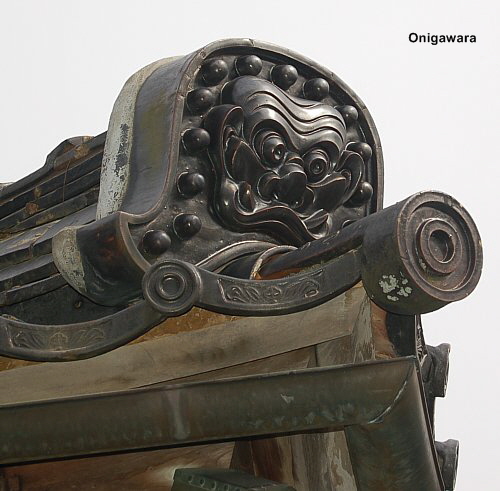
Onigawara atop the Ishitani Residence 石谷家住宅 in Chizu City, Tottori
Photo by A to Z Dictionary of Japanese Buddhism
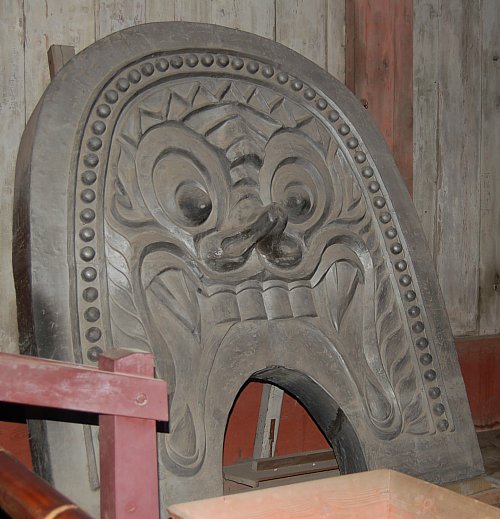
Old tile on display inside Tōdaiji Kondō 東大寺金堂 (Nara)
Photo by A to Z Dictionary of Japanese Buddhism

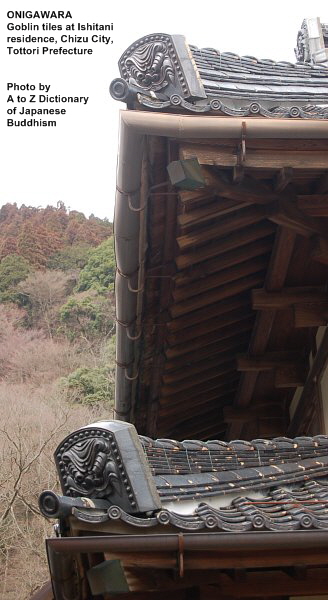  Says JAANUS Says JAANUS
(Japanese Architecture and
Art Net Users System)
- ~jaanus/deta/o/onigawara.htm. Onigawara 鬼瓦. Lit. goblin tile. The genelic name for decorative roof tiles found at the ends of a main ridge *oomune 大棟, or descending ridge (kudarimune 降棟). In the Nara and Heian periods they were usually decorated with flower or animal designs, and in the Kamakura period with a goblin (oni 鬼) mask. Usually tile but occasionally made of stone or wood. Swirling or wave patterns found at the bottom right and left of the onigawara are called Hire 鰭. In the case of temples, shrines and palaces the terms Oni-ita 鬼板 or Hanagawara 花瓦 are sometimes used insted of onigawara.
- ~jaanus/deta/o/oniita.htm. Oni-ita 鬼板. A wooden board or an undecorated tile used in place of ogre face tiles (onigawara 鬼瓦) at each end of the main ridge. Originally, in the 7c-8c, tiles were used as a device to prevent leaks and general weathering on the ridge ends. According to some scholars, these were rarely decorated with an ogre face, but were left plain. Oni-ita are believed to have appeared first in the 8c and became very popular during the Heian period (794-1185). Many oni-ita were covered with copper sheeting in later periods. The name in later periods, is also used for a ridge-end plate with an ogre mask. A few examples can be seen on miniature shrines (zushi 厨子) placed within the (hondou 本堂), the chief sanctuary, of a temple. One example of wooden oni-ita with an ogre mask attached is found at Joukouji Hondou 定光寺本堂 (between 14c-16c) Aichi prefecture and Houjuuji Kokuuzoudou 法住寺虚空蔵堂 (1485) Nagano prefecture.
- ~jaanus/deta/h/hanagawara.htm. Hanagawara 花瓦. Also hashigawara 端瓦. Lit. flower tile. An edge or border tile originally, the word came to replace the more difficult term (abumigawara 鎧瓦) which in 7c-12c was usually decorated with a stylized lotus flower pattern (rengemon 蓮華文). The WAMYOURUIJUUSHUU 倭名類聚鈔 (10c), a kind of dictionary, included hanagawara, and hashigawara 端瓦 (lit. end or edge tile), a term with a similar meaning. By the late Heian period, a comma pattern (tomoemon 巴文) came to be preferred over the lotus pattern and it is possible from that time on the terms hanagawara and hashigawara were gradually superceded by tomoegawara 巴瓦. In the 7c-12c, hanagawara and hashigawara became interchangeable and were also applied to the broad concave eave-end pendant tile (nokihiragawara 軒平瓦).

OTHER RESOURCES
- http://www.nhk.or.jp/nhkworld/english/tv/senseofjapan/archives090044.html
The oni is the havoc-wreaking bad guy, the ogre or demon of Japanese folk tales, often depicted with a horn or pair of horns on its head and sharp fangs in its mouth. It seems to be a composite monster drawn from Buddhist hell and demons, evil spirits of the Yin-Yang theory, and Chinese ghosts and ghouls. But the Japanese oni is worshipped, too, as an awe-inspiring figure. At a festival in northern Japan, men disguised as oni, called namahage 生剥 (なまはげ), visit each home to scare the small children. It's a ritual warning to behave well, but also a prayer for their health. You also sometimes see oni tiles (onigawara) on the roofs of old houses, put there to drive evil spirits away.
- Bean-Throwing Ceremony, Setsubun 節分. February 3 each year. A major event, but not a national holiday. People nationwide throw beans outside their home and inside their home chanting Oni wa Soto, Fuku wa Uchi 鬼は外福は内 (Get out Ogre! Come in Happiness!). See Setsubun in Japan; A Lunar New Years' Eve by Steve Renshaw and Saori Ihara. There are many adages involving the word “oni.” For example, Oni ni Kanabō 鬼に金棒 (lit. “Giving an iron rod to an oni”) means to give a strong person an extra advantage, while Oni-no kakuran 鬼の霍乱 means “even oni get sick,” which signifies that even a devilishly healthy person can get sick. The phrase is akin to “even monkeys fall from trees.”
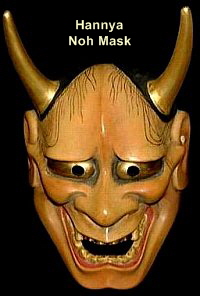  Japanese Oni Masks. Hannya 般若. Says JAANUS: “A noh mask (nōmen 能面) representing a female serpent-demon filled with malicious jealousy and hatred. Two sharp horns sprout from the temples and bulbous, metallic eyes lie half hidden beneath scowling brows. The gaping mouth is full of gold teeth, with upper and lower fangs that heighten her ferocity. The flesh tone of the face varies depending on the social rank of the woman portrayed, with a lighter complexion indicating aristocratic status. Worn by the protagonist, shite シテ, in the second acts of AOI NO UE 葵上, DŌJŌJI 道成寺, KUROZUKA 黒塚, and MOMIJIGARI 紅葉狩. The first two plays depict women betrayed or spurned by their lovers; the second two portray demons who first appear in human form to trap the unwary. Several traditions account for the name "hannya." The most plausible account traces the origins of the mask to the mask carver Hannyabō 般若坊, who was active in the late 15th or early 16th century. “ <end quote> Japanese Oni Masks. Hannya 般若. Says JAANUS: “A noh mask (nōmen 能面) representing a female serpent-demon filled with malicious jealousy and hatred. Two sharp horns sprout from the temples and bulbous, metallic eyes lie half hidden beneath scowling brows. The gaping mouth is full of gold teeth, with upper and lower fangs that heighten her ferocity. The flesh tone of the face varies depending on the social rank of the woman portrayed, with a lighter complexion indicating aristocratic status. Worn by the protagonist, shite シテ, in the second acts of AOI NO UE 葵上, DŌJŌJI 道成寺, KUROZUKA 黒塚, and MOMIJIGARI 紅葉狩. The first two plays depict women betrayed or spurned by their lovers; the second two portray demons who first appear in human form to trap the unwary. Several traditions account for the name "hannya." The most plausible account traces the origins of the mask to the mask carver Hannyabō 般若坊, who was active in the late 15th or early 16th century. “ <end quote>
- To view other oni masks, see this J-site or this J-site.
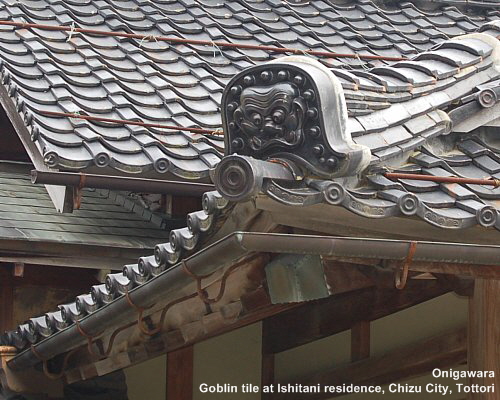
Photo by A to Z Dictionary of Japanese Buddhism
LEARN MORE

|
|